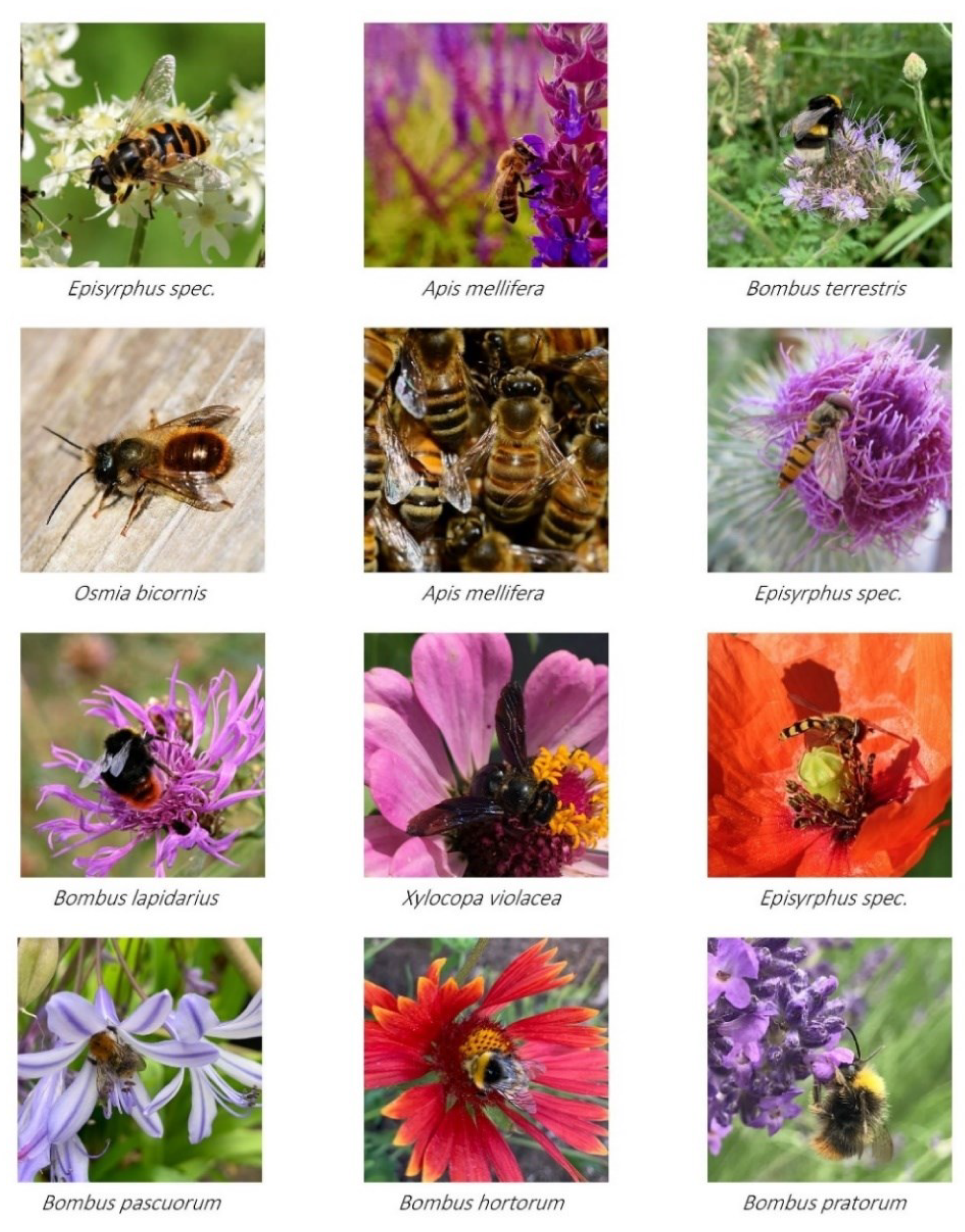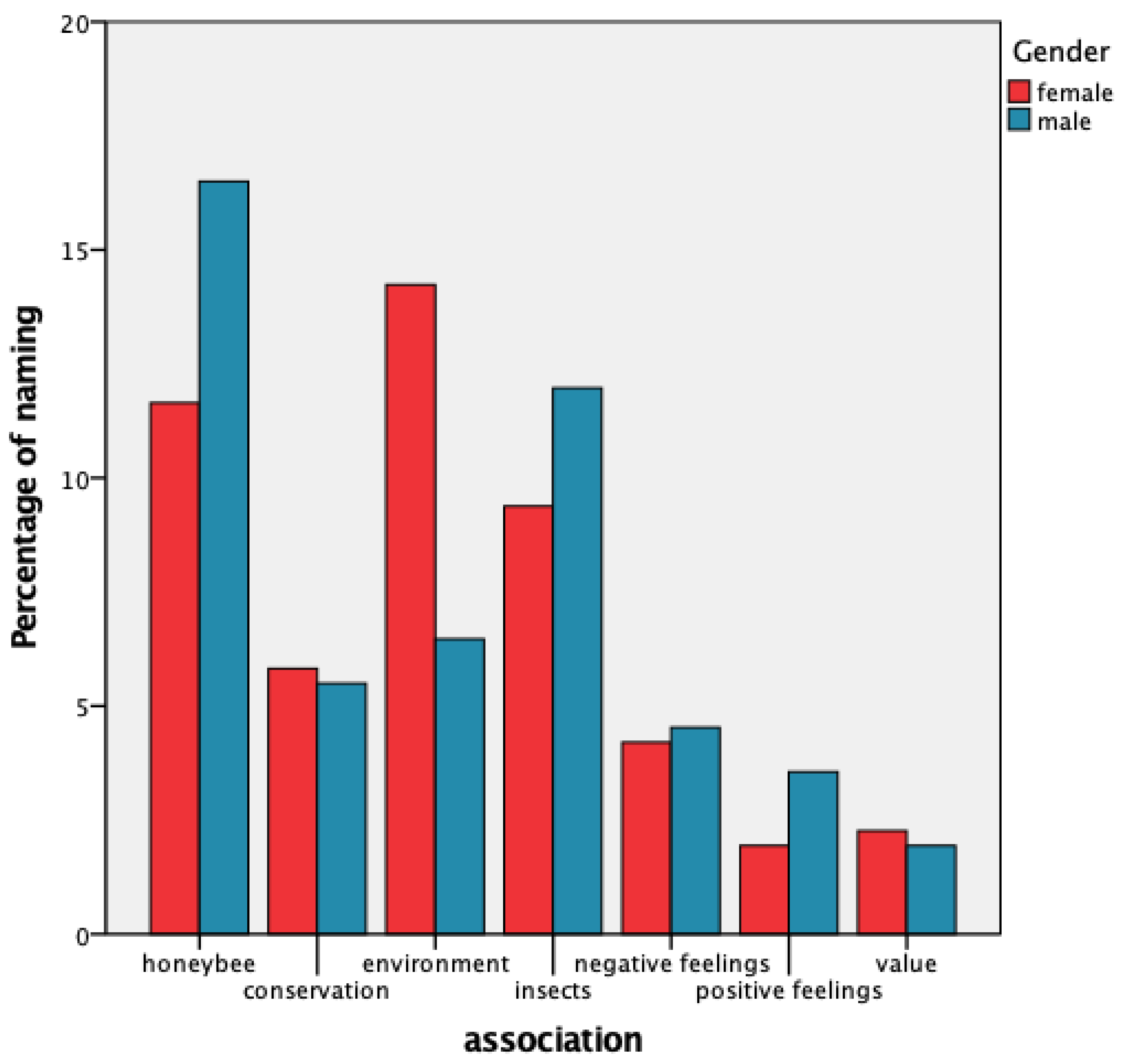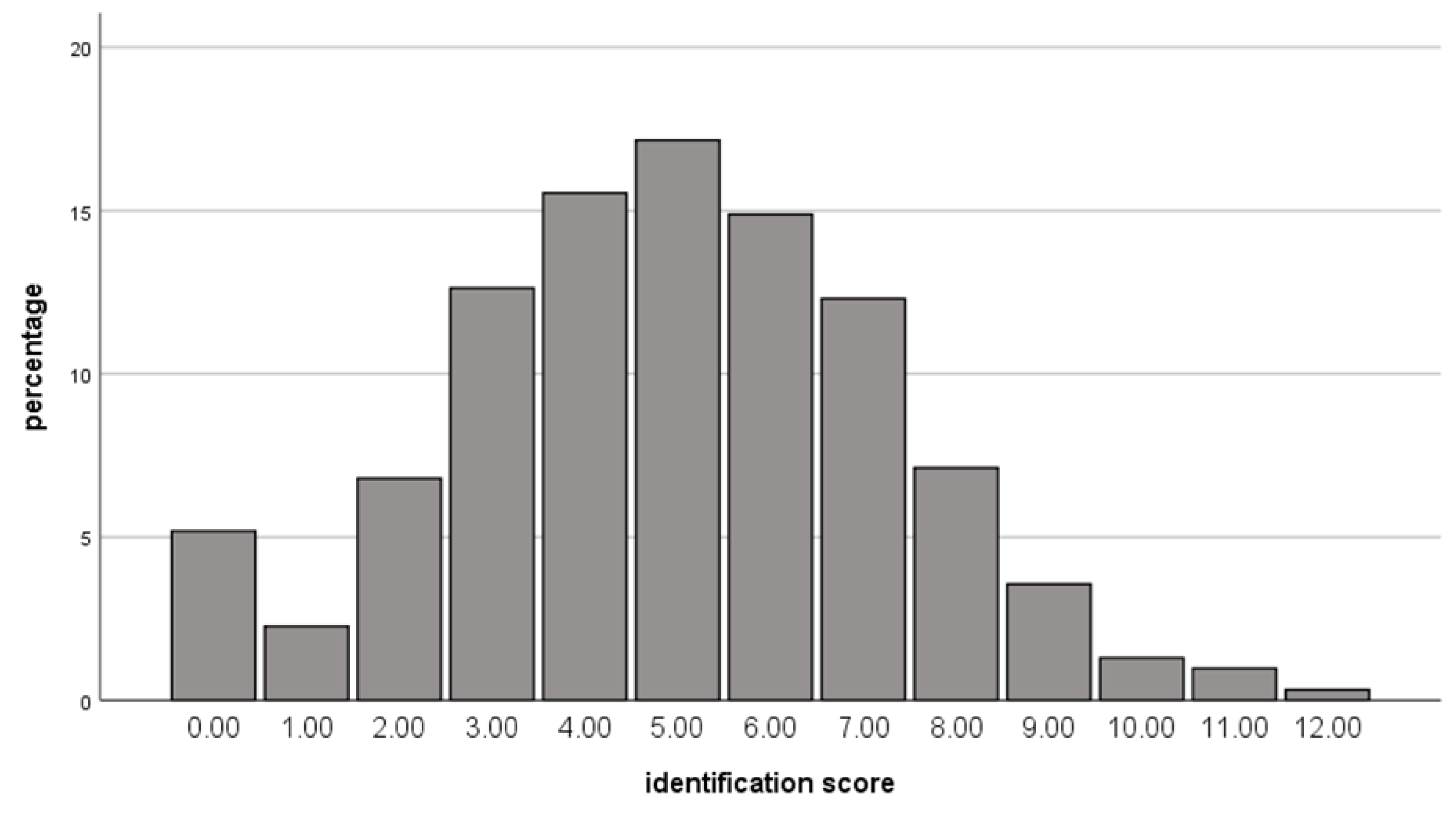SAD but True: Species Awareness Disparity in Bees Is a Result of Bee-Less Biology Lessons in Germany
Abstract
:1. Introduction
1.1. Economic and Ecologic Value of Bees and Loss of Insect Biodiversity
1.2. A Bee or Not a Bee? A Matter of Language
1.3. From ‘Species Diversity Blindness’ to ‘Species Awareness Disparity’ for Bees
1.4. Lack of Bee Biodiversity in the Biology Classroom—A Promotor of SAD?
- (1)
- What do children and young adolescents associate with the term ‘wild bee’?
- (2)
- Are children and young adolescents aware of species diversity in ‘wild bees’?
- (3)
- Are children and young adolescents capable of differentiating honeybees from other wild bees and insects?
2. Materials and Methods
2.1. Questionnaire
2.2. Data Analysis
3. Results
4. Discussion
5. Limitations
6. SAD Is Not Always Bad—Conclusions and Implications for Education and Conservation
Author Contributions
Funding
Institutional Review Board Statement
Informed Consent Statement
Data Availability Statement
Acknowledgments
Conflicts of Interest
References
- Sánchez-Bayo, F.; Wyckhuys, K.A. Further evidence for a global decline of the entomofauna. Austral. Entomol. 2021, 60, 9–26. [Google Scholar] [CrossRef]
- Wagner, D.L.; Grames, E.M.; Forister, M.L.; Berenbaum, M.R.; Stopak, D. Insect decline in the Anthropocene: Death by a thousand cuts. Proc. Natl. Acad. Sci. USA 2021, 118, e2023989118. [Google Scholar] [CrossRef] [PubMed]
- Sánchez-Bayo, F.; Wyckhuys, K.A. Worldwide decline of the entomofauna: A review of its drivers. Biol. Conserv. 2019, 232, 8–27. [Google Scholar] [CrossRef]
- Althaus, S.L.; Berenbaum, M.R.; Jordan, J.; Shalmon, D.A. No buzz for bees: Media coverage of pollinator decline. Proc. Natl. Acad. Sci. USA 2021, 118, e2002552117. [Google Scholar] [CrossRef] [PubMed]
- Hallmann, C.A.; Sorg, M.; Jongejans, E.; Siepel, H.; Hofland, N.; Schwan, H.; Stenmans, W.; Müller, A.; Sumser, H.; Hörren, T.; et al. More than 75 percent decline over 27 years in total flying insect biomass in protected areas. PLoS ONE 2017, 12, e0185809. [Google Scholar] [CrossRef] [Green Version]
- Hartmann, H.; Haensel, M.; Riebl, R.; Lohse, E.J.; Koellner, T. Volksbegehren Artenvielfalt: Gesetzesänderungen können auch Ökosystemdienstleistungen in Bayerns Agrarlandschaften stärken. GAIA-Ecol. Perspect. Sci. Soc. 2021, 30, 106–113. [Google Scholar] [CrossRef]
- Klein, A.-M.; Vaissière, B.E.; Cane, J.H.; Steffan-Dewenter, I.; Cunningham, S.A.; Kremen, C.; Tscharntke, T. Importance of pollinators in changing landscapes for world crops. Proc. R. Soc. B Biol. Sci. 2007, 274, 303–313. [Google Scholar] [CrossRef] [Green Version]
- Leonhardt, S.D.; Gallai, N.; Garibaldi, L.A.; Kuhlmann, M.; Klein, A.-M. Economic gain, stability of pollination and bee diversity decrease from southern to northern Europe. Basic Appl. Ecol. 2013, 14, 461–471. [Google Scholar] [CrossRef]
- Goulson, D.; Nicholls, E.; Botías, C.; Rotheray, E.L. Bee declines driven by combined stress from parasites, pesticides, and lack of flowers. Science 2015, 347, 1255957. [Google Scholar] [CrossRef]
- Papanikolaou, A.D.; Kühn, I.; Frenzel, M.; Kuhlmann, M.; Poschlod, P.; Potts, S.G.; Roberts, S.P.M.; Schweiger, O. Wild bee and floral diversity covary in response to the direct and indirect impacts of land use. Ecosphere 2017, 8, e02008. [Google Scholar] [CrossRef]
- Ritchie, A.D.; Ruppel, R.; Jha, S. Generalist Behavior Describes Pollen Foraging for Perceived Oligolectic and Polylectic Bees. Environ. Entomol. 2016, 45, 909–919. [Google Scholar] [CrossRef]
- Amiet, F.; Krebs, A.; Müller, A. Bienen Mitteleuropas. Gattungen, Lebensweise, Beobachtung. 3. Auflage; Haupt Verlag: Bern, Switzerland, 2019. [Google Scholar]
- Garantonakis, N.; Varikou, K.; Birouraki, A.; Edwards, M.; Kalliakaki, V.; Andrinopoulos, F. Comparing the pollination services of honey bees and wild bees in a watermelon field. Sci. Hortic. 2016, 204, 138–144. [Google Scholar] [CrossRef]
- Ollerton, J. Pollinators & Pollination: Nature and Society; Pelagic Publishing: Exeter, UK, 2021. [Google Scholar]
- Bhattacharyya, M.; Acharya, S.K.R.; Chakraborty, S.K. Pollinators Unknown: People’s Perception of Native Bees in an Agrarian District of West Bengal, India, and Its Implication in Conservation. Trop. Conserv. Sci. 2017, 10, 1940082917725440. [Google Scholar] [CrossRef]
- Winfree, R.; Bartomeus, I.; Cariveau, D.P. Native Pollinators in Anthropogenic Habitats. Annu. Rev. Ecol. Evol. Syst. 2011, 42, 1–22. [Google Scholar] [CrossRef] [Green Version]
- Smith, T.J.; Saunders, M.E. Honey bees: The queens of mass media, despite minority rule among insect pollinators. Insect Conserv. Divers. 2016, 9, 384–390. [Google Scholar] [CrossRef]
- Gallai, N.; Salles, J.-M.; Settele, J.; Vaissière, B.E. Economic valuation of the vulnerability of world agriculture confronted with pollinator decline. Ecol. Econ. 2009, 68, 810–821. [Google Scholar] [CrossRef]
- Potts, S.G.; Biesmeijer, J.C.; Kremen, C.; Neumann, P.; Schweiger, O.; Kunin, W.E. Global pollinator declines: Trends, impacts and drivers. Trends Ecol. Evol. 2010, 25, 345–353. [Google Scholar] [CrossRef]
- Breeze, T.D.; Bailey, A.P.; Balcombe, K.G.; Potts, S.G. Pollination services in the UK: How important are honeybees? Agric. Ecosyst. Environ. 2011, 142, 137–143. [Google Scholar] [CrossRef] [Green Version]
- Garibaldi, L.A.; Steffan-Dewenter, I.; Winfree, R.; Aizen, M.A.; Bommarco, R.; Cunningham, S.A.; Kremen, C.; Carvalheiro, L.G.; Harder, L.D.; Afik, O.; et al. Wild pollinators enhance fruit set of crops regardless of honey bee abundance. Science 2013, 339, 1608–1611. [Google Scholar] [CrossRef]
- Westrich, P.; Frommer, U.; Mandery, K.; Riemann, H.; Ruhnke, H.; Saure, C.; Voith, J. Rote Liste und Gesamtartenliste der Bienen (Hymenoptera: Apidae) Deutschlands. Fass. Febr. 2011, 70, 373–416. [Google Scholar]
- Bogusch, P.; Bláhová, E.; Horák, J. Pollen specialists are more endangered than non-specialised bees even though they collect pollen on flowers of non-endangered plants. Anthr. Plant-Interact. 2020, 14, 759–769. [Google Scholar] [CrossRef]
- Falk, S.J. Field Guide to the Bees of Great Britain and Ireland. Unter Mitarbeit von Richard Lewington, Reprinted with Corrections; Bloomsbury Wildlife Guides: London, UK, 2006. [Google Scholar]
- Wissenschaftlicher Rat der Dudenredaktion (Hg.). Duden. Das Grosse Wörterbuch der Deutschen Sprache in 10 Bänden. Band 10. Band 4. 3. Aufl.; Dudenverlag: Mannheim, Germany, 1999. [Google Scholar]
- Wahrig-Burfeind, R. Brockhaus Wahrig Deutsches Wörterbuch. Mit Einem Lexikon der Sprachlehre. 9. Vollständig Neu Bearbeitete und Aktualisierte Aufl.; Wissenmedia: Gütersloh, Germany, 2011. [Google Scholar]
- Kluge, F.; Seebold, E. Etymologisches Wörterbuch der Deutschen Sprache. 25. Durchgesehene und Erw. Aufl.; De Gruyter: Berlin, Germany; Boston, MA, USA, 2011. [Google Scholar]
- Westrich, P. Wildbienen: Die anderen Bienen. 5. Aufl.; Pfeil: München, Germany, 2015. [Google Scholar]
- Westrich, P. Die Wildbienen Deutschlands. 2. Aufl.; Ulmer, E., Ed.; Verlag Eugen Ulmer: Stuttgart, Germany, 2019. [Google Scholar]
- Wandersee, J.H.; Schussler, E.E. Toward a theory of plant blindness. Plant Sci. Bull. 2001, 47, 2–9. [Google Scholar]
- Oliveira, W.; Silva, J.L.S.; Porto, R.; Cruz-Neto, O.; Tabarelli, M.; Viana, B.F.; Peres, C.A. Plant and Pollination Blindness: Risky Business for Human Food Security. BioScience 2019, 70, 109–110. [Google Scholar] [CrossRef]
- Parsley, K.M. Plant awareness disparity: A case for renaming plant blindness. Plants People Planet 2020, 2, 598–601. [Google Scholar] [CrossRef]
- Schussler, E.E.; Olzak, L.A. It’s not easy being green: Student recall of plant and animal images. J. Biol. Educ. 2008, 42, 112–119. [Google Scholar] [CrossRef]
- Feldman, J. What is a visual object? Trends Cogn. Sci. 2003, 7, 252–256. [Google Scholar] [CrossRef]
- Knapp, S. Are humans really blind to plants? Plants People Planet 2019, 1, 164–168. [Google Scholar] [CrossRef]
- Kellert, S.R. Attitudes, Knowledge, and Behavior toward Wildlife among the Industrial Superpowers: United States, Japan, and Germany. J. Soc. Issues 1993, 49, 53–69. [Google Scholar] [CrossRef]
- Bjerke, T.; Østdahl, T. Animal-related attitudes and activities in an urban population. Anthrozoös 2004, 17, 109–129. [Google Scholar] [CrossRef]
- Retzlaff-Fürst, C. Das Lebende Tier im Schülerurteil. Bodenlebewesen im Biologieunterricht-Eine Empirische Studie. Didaktik in Forschung und Praxis, Bd. 40; Kovač: Hamburg, Germany, 2008. [Google Scholar]
- Urhahne, D.; Jeschke, J.; Krombaß, A.; Harms, U. Die Validierung von Fragebogenerhebungen zum Interesse an Tieren und Pflanzen durch computergestützte Messdaten. Z. Pädagogische Psychol. 2004, 18, 213–219. [Google Scholar] [CrossRef]
- Lindemann-Matthies, P.; Bose, E. How Many Species Are There? Public Understanding and Awareness of Biodiversity in Switzerland. Hum. Ecol. 2008, 36, 731–742. [Google Scholar] [CrossRef] [Green Version]
- Fančovičová, J.; Prokop, P. Plants have a chance: Outdoor educational programmes alter students’ knowledge and attitudes towards plants. Environ. Educ. Res. 2011, 17, 537–551. [Google Scholar] [CrossRef]
- Scott, G.W.; Goulder, R.; Wheeler, P.; Scott, L.J.; Tobin, M.L.; Marsham, S. The Value of Fieldwork in Life and Environmental Sciences in the Context of Higher Education: A Case Study in Learning about Biodiversity. J. Sci. Educ. Technol. 2012, 21, 11–21. [Google Scholar] [CrossRef]
- Silveira, F.A.O.; Ordóñez-Parra, C.A.; Moura, L.C.; Schmidt, I.B.; Andersen, A.N.; Bond, W.; Buisson, E.; Durigan, G.; Fidelis, A.; Oliveira, R.S.; et al. Biome Awareness Disparity is BAD for tropical ecosystem conservation and restoration. J. Appl. Ecol. 2021, 00, 1–9. [Google Scholar] [CrossRef]
- Horsley, S.; Hohbein, R.; Morrow, K.; Green, G.T. What’s in a name? A content analysis of environmental NGOs’ use of “iconic species” in press releases. Biodivers. Conserv. 2020, 29, 2711–2728. [Google Scholar] [CrossRef]
- Macdonald, E.A.; Hinks, A.; Weiss, D.J.; Dickman, A.; Burnham, D.; Sandom, C.J.; Malhi, Y.; Macdonald, D.W. Identifying ambassador species for conservation marketing. Glob. Ecol. Conserv. 2017, 12, 204–214. [Google Scholar] [CrossRef]
- Ministerium für Bildung, Wissenschaft und Weiterbildung und Kultur. Lehrpläne für die Naturwissenschaftlichen Fächer Für die Weiterführenden Schulen in Rheinland-Pfalz. Biologie, Chemie, Physik. Klassenstufen 7 bis 9/10; Ministerium für Bildung, Wissenschaft und Weiterbildung und Kultur: Mainz, Germany, 2014. [Google Scholar]
- Berck, K.-H.; Graf, D. Biologiedidaktik. Grundlagen und Methoden. Unter Mitarbeit von Anke Fischer und Melek Yaman. 5. Aktualisierte Auflage; Quelle & Meyer: Wiebelsheim, Germany, 2018. [Google Scholar]
- Bickel, H.; Claus, R.; Frank, R.; Haala, G.; Lüdecke, M.; Wichert, G.; Zohren, D. Natura. Biologie für Gymnasien. 7. Bis 10 Schuljah; Ernst Klett: Stuttgart, Germany, 2002. [Google Scholar]
- Dobers, J.; Freundner-Huneke, I.; Schulu, S.; Zeeb, A. Erlebnis Biologie. Gesamtband ab 7. Schuljahr; Schroedel: Braunschweig, Germany, 2010. [Google Scholar]
- Hausfeld, R.; Schulenberg, W.; Bioskop, S.I. Gymnasium Rheinland-Palz, Druck A; Westermann: Braunschweig, Germany, 2016. [Google Scholar]
- Batke, S.P.; Dallimore, T.; Bostock, J. Understanding Plant Blindness–Students’ Inherent Interest of Plants in Higher Education. J. Plant Sci. 2020, 8, 98–105. [Google Scholar] [CrossRef]
- Prokop, P.; Tunnicliffe, S.D. “Disgusting” Animals: Primary School Children’s Attitudes and Myths of Bats and Spiders. Eurasia J. Math. Sci. Technol. Educ. 2008, 4, 87–97. [Google Scholar] [CrossRef]
- Kellert, S.R. Values and Perceptions of Invertebrates. Conserv. Biol. 1993, 7, 845–855. [Google Scholar] [CrossRef]
- Schönfelder, M.L.; Bogner, F.X. Individual perception of bees: Between perceived danger and willingness to protect. PLoS ONE 2017, 12, e0180168. [Google Scholar] [CrossRef] [Green Version]
- Arrindell, W.A. Phobic dimensions: IV. The structure of animal fears. Behav. Res. Ther. 2000, 38, 509–530. [Google Scholar] [CrossRef]
- Gerdes, A.B.M.; Uhl, G.; Alpers, G.W. Spiders are special: Fear and disgust evoked by pictures of arthropods. Evol. Hum. Behav. 2009, 30, 66–73. [Google Scholar] [CrossRef]
- Sieg, A.-K.; Teibtner, R.; Dreesmann, D. Don’t Know Much about Bumblebees? A Study about Secondary School Students’ Knowledge and Attitude Shows Educational Demand. Insects 2018, 9, 57. [Google Scholar] [CrossRef] [Green Version]
- Sieg, A.-K.; Dreesmann, D. Promoting Pro-Environmental BEEhavior in School. Factors Leading to Eco-Friendly Student Action. Sustainability 2021, 13, 6598. [Google Scholar] [CrossRef]
- Bellmann, H. Der Kosmos Insektenführer; Franckh-Kosmos: Stuttgart, Germany, 2018. [Google Scholar]
- Chinery, M. Parey’s Buch der Insekten. In Über 2000 Insekten Europas; Franckh-Kosmos: Stuttgart, Germany, 2012. [Google Scholar]
- Field, A. Discovering Statistics Using IBM SPSS Statistics, 5th ed.; SAGE Publications: Los Angeles, CA, USA; London, UK; New Delhi, India; Singapore; Washington, DC, USA; Melbourne, Australia, 2018. [Google Scholar]
- Holstermann, N.; Bögeholz, S. Interesse von Jungen und Mädchen an naturwissenschaftlichen Themen am Ende der Sekundarstufe I. Z. Didakt. Nat. 2007, 13, 71–86. [Google Scholar]
- Prokop, P.; Tunnicliffe, S.D. Effects of having pets at home on children’s attitudes toward popular and unpopular animals. Anthrozoös 2010, 23, 21–35. [Google Scholar] [CrossRef]
- Ballouard, J.-M.; Brischoux, F.; Bonnet, X. Children prioritize virtual exotic biodiversity over local biodiversity. PLoS ONE 2011, 6, e23152. [Google Scholar] [CrossRef] [Green Version]
- Schlegel, J.; Breuer, G.; Rupf, R. Local Insects as Flagship Species to Promote Nature Conservation? A Survey among Primary School Children on Their Attitudes toward Invertebrates. Anthrozoös 2015, 28, 229–245. [Google Scholar] [CrossRef]
- Schlegel, J.; Rupf, R. Attitudes towards potential animal flagship species in nature conservation: A survey among students of different educational institutions. J. Nat. Conserv. 2010, 18, 278–290. [Google Scholar] [CrossRef]
- Kahn, P.H., Jr. Children’s affiliations with nature: Structure, development, and the problem of environmental generational amnesia. In Children and Nature: Psychological, Sociocultural, and Evolutionary Investigations; Kahn, P.H., Jr., Kellert, S.R., Eds.; MIT: Cambridge, UK, 2002; pp. 93–116. [Google Scholar]
- Samways, M.J. Rescuing the extinction of experience. Biodivers. Conserv. 2007, 16, 1995–1997. [Google Scholar] [CrossRef] [Green Version]
- Swiss Biodiversity Forum (Hrsg.). Biodiversität in der Schweiz–Zustand, Erhaltung, Perspektiven; Haupt Verlag: Bern, Switzerland, 2004. [Google Scholar]
- Cho, Y.; Lee, D. ‘Love honey, hate honey bees’: Reviving biophilia of elementary school students through environmental education program. Environ. Educ. Res. 2018, 24, 445–460. [Google Scholar] [CrossRef]
- Bonn, A.; Richter, A.; Vohland, K.; Pettibone, L.; Brandt, M.; Feldmann, R.; Goebel, C.; Grefe, C.; Hecker, S.; Henken, L.; et al. Grünbuch Citizen Science Strategie 2020 für Deutschland; Helmholtz Zentrum für Umweltforschung (UFZ), Deutsches Zentrum für integrative Biodiversitätsforschung (iDiv), Halle-Jena-Leipzig, Museum für Naturkunde Berlin, Leibniz- Institut für Evolutions- und Biodiversitätsforschung (MfN), Berlin-brandenburgisches Institut für Biodiversitätsforschung (BBIB): Berlin, Germany, 2016. [Google Scholar]
- Ganzevoort, W.; Van Den Born, R.J.G. Counting Bees: Learning Outcomes from Participation in the Dutch National Bee Survey. Sustainability 2021, 13, 4703. [Google Scholar] [CrossRef]
- Ruiz-Mallén, I.; Riboli-Sasco, L.; Ribrault, C.; Heras, M.; Laguna, D.; Perié, L. Citizen Science. Sci. Commun. 2016, 38, 523–534. [Google Scholar] [CrossRef]
- Vohland, K.; Land-Zandstra, A.; Ceccaroni, L.; Lemmens, R.; Perelló, J.; Samson, R.P.M.; Wagenknecht, K. The Science of Citizen Science; Springer International Publishing: Berlin/Heidelberg, Germany, 2021. [Google Scholar] [CrossRef]
- Kreuzer, P.; Dreesmann, D. Museum behind the scenes–an inquiry-based learning unit with biological collections in the classroom. J. Biol. Educ. 2016, 51, 261–272. [Google Scholar] [CrossRef]
- Harlin, J.; Kloetzer, L.; Patton, D.; Leonhard, C.; Leysin American School High School Students. Turning students into citizen scientists. In Citizen Science: Innovation in Open Science, Society and Policy; Hecker, S., Haklay, M., Bowser, A., Makuch, Z., Vogel, J., Bonn, A., Eds.; UCL Press: London, UK, 2018. [Google Scholar] [CrossRef]
- Zoellick, B.; Nelson, S.J.; Schauffler, M. Participatory science and education: Bringing both views into focus. Front. Ecol. Environ. 2012, 10, 310–313. [Google Scholar] [CrossRef]
- Vitone, T.; Stofer, K.; Steininger, M.S.; Hulcr, J.; Dunn, R.; Lucky, A. School of Ants goes to college: Integrating citizen science into the general education classroom increases engagement with science. J. Sci. Commun. 2016, 15, A03. [Google Scholar] [CrossRef] [Green Version]
- Falk, S.; Foster, G.; Comont, R.; Conroy, J.; Bostock, H.; Salisbury, A.; Kilbey, D.; Bennett, J.; Smith, B. Evaluating the ability of citizen scientists to identify bumblebee (Bombus) species. PLoS ONE 2019, 14, e0218614. [Google Scholar] [CrossRef] [Green Version]
- Jørgensen, F.A.; Jørgensen, D. Citizen science for environmental citizenship. Conserv. Biol. 2021, 35, 1344. [Google Scholar] [CrossRef]
- Adamou, A.; Georgiou, Y.; Paraskeva-Hadjichambi, D.; Hadjichambis, A.C. Environmental Citizen Science Initiatives as a Springboard towards the Education for Environmental Citizenship: A Systematic Literature Review of Empirical Research. Sustainability 2021, 13, 13692. [Google Scholar] [CrossRef]
- Kawahara, A.Y.; Reeves, L.E.; Barber, J.A.; Black, S.H. Eight simple actions that individuals can take to save insects from global declines. Proc. Natl. Acad. Sci. USA 2021, 118, e2002547117. [Google Scholar] [CrossRef]
- Brühl, C.A.; Bakanov, N.; Köthe, S.; Eichler, L.; Sorg, M.; Hörren, T.; Mühlethaler, R.; Meinel, G.; Lehmann, G.U.C. Direct pesticide exposure of insects in nature conservation areas in Germany. Sci. Rep. 2021, 11, 24144. [Google Scholar] [CrossRef]



| 5th Grade | 6th Grade | 7th Grade | |
|---|---|---|---|
| Female | 52 | 46 | 84 |
| Male | 64 | 25 | 117 |
| No indication of gender | 1 | 0 | 6 |
| Age | 11–12 years | 12–13 years | 13–14 years |
| Total | 117 | 71 | 207 |
| Category | Examples | Naming (%) |
|---|---|---|
| honeybee | ‘honey’; ‘honeybee’; ‘hive’ | 28.1 |
| conservation | ‘flowers and conservation’; ‘decline of insects’; ‘threat’ | 10.9 |
| environment | ‘environment’; ‘flowers’; ‘forest’ | 20.0 |
| insects | ‘busy bees’; ‘insects’; ‘wasps’ | 20.9 |
| positive feelings | ‘interesting’; ‘cute/nice bees’ | 5.3 |
| negative feelings | ‘fear’; ‘disgusting’; ‘stinging’ ‘insects’ | 9.4 |
| value | ‘pollination’; ‘fruits’ | 4.4 |
| no answer | ‘don’t know’ | 1.0 |
| Species | Proportion of Correct Answers |
|---|---|
| honeybee | 48.5% |
| wild bees | |
| Xylocopa violacea | 30.2% |
| Bombus terrestris | 31.7% |
| Bombus lapidarius | 38.7% |
| Bombus hortorum | 39.6% |
| Bombus pratorum | 40.9% |
| Osmia bicornis | 46.3% |
| Bombus pascuorum | 52.4% |
| hoverflies | 64.6% |
Publisher’s Note: MDPI stays neutral with regard to jurisdictional claims in published maps and institutional affiliations. |
© 2022 by the authors. Licensee MDPI, Basel, Switzerland. This article is an open access article distributed under the terms and conditions of the Creative Commons Attribution (CC BY) license (https://creativecommons.org/licenses/by/4.0/).
Share and Cite
Christ, L.; Dreesmann, D.C. SAD but True: Species Awareness Disparity in Bees Is a Result of Bee-Less Biology Lessons in Germany. Sustainability 2022, 14, 2604. https://doi.org/10.3390/su14052604
Christ L, Dreesmann DC. SAD but True: Species Awareness Disparity in Bees Is a Result of Bee-Less Biology Lessons in Germany. Sustainability. 2022; 14(5):2604. https://doi.org/10.3390/su14052604
Chicago/Turabian StyleChrist, Laura, and Daniel C. Dreesmann. 2022. "SAD but True: Species Awareness Disparity in Bees Is a Result of Bee-Less Biology Lessons in Germany" Sustainability 14, no. 5: 2604. https://doi.org/10.3390/su14052604
APA StyleChrist, L., & Dreesmann, D. C. (2022). SAD but True: Species Awareness Disparity in Bees Is a Result of Bee-Less Biology Lessons in Germany. Sustainability, 14(5), 2604. https://doi.org/10.3390/su14052604






